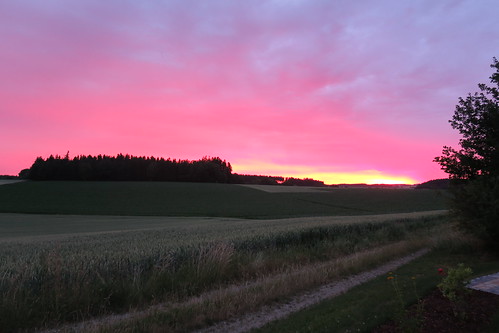59- GTGGACACTATACTCAGGTG-39/59-TCCAACTTGGAATCAAAGGG-39, PR2b 59-AGGTGTTTGCTATGGAATGC-39/ 59-TCTGTACCCACCATCTTGC-39, ERF1 59GCTCTTAACGTCGGATGGTC-39/59-AGCCAAACCCTAGCTCCATT-39, LOX 59-AAAACCTATGCCTCAAGAAC39/59-ACTGCTGCATAGGCTTTGG-39 and EF1a 59AGAGGCCCTCAGACAAAC-39/59-TAGGTCCAAAGGTCACAA-39. The induction ratio of treatment/control was then calculated by the 2-DDCT strategy. Student t-test was employed for statistical evaluation. Results Generation with the PsCRN70-transgenic N. benthamiana Introduction of PsCRN70 gene into N. benthamiana were achieved by Agrobacterium-mediated leaf disc transformation. Integration in the PsCRN70 and GFP transgenes have been confirmed by PCR analysis. Thirty independent transgenic lines like ten GFP-transgenic plants and twenty PsCRN70-transgenic plants had been obtained, and fifteen of them have been randomly chosen and selfpollinated to generate T1 lines. RT-PCR evaluation confirmed that the GFP:PsCRN70 fusion genes were very expressed in 4 independent T1 transgenic lines. The seedlings with the transgenic progenies have been screened by checking fluorescent signal of GFP for further analyses. We confirmed the expression of GFP:PsCRN70 fusion protein utilizing Western blot in transgenic lines, plus the outcome showed that the fusion protein was properly expressed. Observation on the GFP fluorescence also validated the expression of the transgenes. No visible differences in plant development along with other PD-168393 phenotypes had been observed among the PsCRN70-transgenic plants as well as the GFP-transgenic lines, indicating that expression of PsCRN70 didn’t impact the development of N. benthamiana below standard growth circumstances. It was reported that the majority of CRN proteins are localized within the plant cell nuclei. To test the subcellular localization in the target proteins, we very first analyzed regardless of whether PsCRN70 harbors an NLS applying the cNLS Mapper software program, plus  the outcome showed that PsCRN70 contained a common NLS within the C-terminal area, indicating that PsCRN70 may possibly also target the plant cell nucleus. We then observed the distribution in the GFP fluorescent signal inside the 4 T2 transgenic plants as well as the GFP-control lines below a confocal microscope utilizing the leaf and root tissues, respectively. The GFP fluorescent signal in the PsCRN70-transgenic lines was dominantly distributed inside the nucleus of your leaf epidermal cells. The fluorescent signal in the root epidermal cells with the PsCRN70transgenic N. benthamiana was also distributed mainly inside the plant nucleus, which was further confirmed by co-localization with DAPI staining. In contrast, the fluorescent signal within the GFP-transgenic lines was equally distributed inside the cytoplasm and nucleus on the leaf and root epidermal cells. Hence, we concluded that PsCRN70 is actually a plant nucleus-localized protein. Confocal microscopy To observe subcellular localization of PsCRN70, the transgenic N. benthamiana CAL-120 leaves have been reduce into small squares. The leaf squares or plant roots have been then immersed into PBS buffer containing 5 mg/mL DAPI for staining of the nuclei for 5 min. Sildes carrying the samples were observed having a Zeiss LSM 710 confocal laser scanning microscope. The excitation wavelength utilised for GFP was 488 nm and 405 nm for DAPI. The GFP-transgenic N. benthamiana leaves were used as the handle. 10781694 Pictures have been progressed utilizing the Zeiss 710 CLSM and Adobe Photoshop application packages. Protein extraction and Western blot analyses The N. benthamiana leaf tissues have been ground in liquid nitrogen. The ground materials w.59- GTGGACACTATACTCAGGTG-39/59-TCCAACTTGGAATCAAAGGG-39, PR2b 59-AGGTGTTTGCTATGGAATGC-39/ 59-TCTGTACCCACCATCTTGC-39, ERF1 59GCTCTTAACGTCGGATGGTC-39/59-AGCCAAACCCTAGCTCCATT-39, LOX 59-AAAACCTATGCCTCAAGAAC39/59-ACTGCTGCATAGGCTTTGG-39 and EF1a 59AGAGGCCCTCAGACAAAC-39/59-TAGGTCCAAAGGTCACAA-39. The induction ratio of treatment/control was then calculated by the 2-DDCT strategy. Student t-test was utilised for statistical evaluation. Results Generation of your PsCRN70-transgenic N. benthamiana Introduction of PsCRN70 gene into N. benthamiana have been accomplished by Agrobacterium-mediated leaf disc transformation. Integration of the PsCRN70 and GFP transgenes were confirmed by PCR analysis. Thirty independent transgenic lines like ten GFP-transgenic plants and twenty PsCRN70-transgenic plants had been obtained, and fifteen of them had been randomly selected and selfpollinated to generate T1 lines. RT-PCR evaluation confirmed that the GFP:PsCRN70 fusion genes have been extremely expressed in four independent T1 transgenic lines. The seedlings on the transgenic progenies have been screened by checking fluorescent signal of GFP for additional analyses. We confirmed the expression of GFP:PsCRN70 fusion protein utilizing Western blot in transgenic lines, as well as the outcome showed that the fusion protein was correctly expressed. Observation on the GFP fluorescence also validated the expression on the transgenes. No visible differences in plant development and other phenotypes were observed between the PsCRN70-transgenic plants and the GFP-transgenic lines, indicating that expression of PsCRN70 didn’t influence the improvement of N. benthamiana below typical development conditions. It was reported that the majority of CRN proteins are localized in the plant cell nuclei. To test the subcellular localization of the target proteins, we initially analyzed regardless of whether PsCRN70 harbors an NLS working with the cNLS Mapper computer software, and also the outcome showed that PsCRN70 contained a typical NLS within the C-terminal area, indicating that PsCRN70 may also target the plant cell nucleus. We then observed the distribution from the GFP fluorescent signal within the 4 T2 transgenic plants and the GFP-control lines beneath a confocal microscope working with the leaf and root tissues, respectively. The GFP fluorescent signal in the PsCRN70-transgenic lines was dominantly distributed within the nucleus on the leaf epidermal cells. The fluorescent signal in the root epidermal cells with the PsCRN70transgenic N. benthamiana was also distributed mainly inside the plant nucleus, which
the outcome showed that PsCRN70 contained a common NLS within the C-terminal area, indicating that PsCRN70 may possibly also target the plant cell nucleus. We then observed the distribution in the GFP fluorescent signal inside the 4 T2 transgenic plants as well as the GFP-control lines below a confocal microscope utilizing the leaf and root tissues, respectively. The GFP fluorescent signal in the PsCRN70-transgenic lines was dominantly distributed inside the nucleus of your leaf epidermal cells. The fluorescent signal in the root epidermal cells with the PsCRN70transgenic N. benthamiana was also distributed mainly inside the plant nucleus, which was further confirmed by co-localization with DAPI staining. In contrast, the fluorescent signal within the GFP-transgenic lines was equally distributed inside the cytoplasm and nucleus on the leaf and root epidermal cells. Hence, we concluded that PsCRN70 is actually a plant nucleus-localized protein. Confocal microscopy To observe subcellular localization of PsCRN70, the transgenic N. benthamiana CAL-120 leaves have been reduce into small squares. The leaf squares or plant roots have been then immersed into PBS buffer containing 5 mg/mL DAPI for staining of the nuclei for 5 min. Sildes carrying the samples were observed having a Zeiss LSM 710 confocal laser scanning microscope. The excitation wavelength utilised for GFP was 488 nm and 405 nm for DAPI. The GFP-transgenic N. benthamiana leaves were used as the handle. 10781694 Pictures have been progressed utilizing the Zeiss 710 CLSM and Adobe Photoshop application packages. Protein extraction and Western blot analyses The N. benthamiana leaf tissues have been ground in liquid nitrogen. The ground materials w.59- GTGGACACTATACTCAGGTG-39/59-TCCAACTTGGAATCAAAGGG-39, PR2b 59-AGGTGTTTGCTATGGAATGC-39/ 59-TCTGTACCCACCATCTTGC-39, ERF1 59GCTCTTAACGTCGGATGGTC-39/59-AGCCAAACCCTAGCTCCATT-39, LOX 59-AAAACCTATGCCTCAAGAAC39/59-ACTGCTGCATAGGCTTTGG-39 and EF1a 59AGAGGCCCTCAGACAAAC-39/59-TAGGTCCAAAGGTCACAA-39. The induction ratio of treatment/control was then calculated by the 2-DDCT strategy. Student t-test was utilised for statistical evaluation. Results Generation of your PsCRN70-transgenic N. benthamiana Introduction of PsCRN70 gene into N. benthamiana have been accomplished by Agrobacterium-mediated leaf disc transformation. Integration of the PsCRN70 and GFP transgenes were confirmed by PCR analysis. Thirty independent transgenic lines like ten GFP-transgenic plants and twenty PsCRN70-transgenic plants had been obtained, and fifteen of them had been randomly selected and selfpollinated to generate T1 lines. RT-PCR evaluation confirmed that the GFP:PsCRN70 fusion genes have been extremely expressed in four independent T1 transgenic lines. The seedlings on the transgenic progenies have been screened by checking fluorescent signal of GFP for additional analyses. We confirmed the expression of GFP:PsCRN70 fusion protein utilizing Western blot in transgenic lines, as well as the outcome showed that the fusion protein was correctly expressed. Observation on the GFP fluorescence also validated the expression on the transgenes. No visible differences in plant development and other phenotypes were observed between the PsCRN70-transgenic plants and the GFP-transgenic lines, indicating that expression of PsCRN70 didn’t influence the improvement of N. benthamiana below typical development conditions. It was reported that the majority of CRN proteins are localized in the plant cell nuclei. To test the subcellular localization of the target proteins, we initially analyzed regardless of whether PsCRN70 harbors an NLS working with the cNLS Mapper computer software, and also the outcome showed that PsCRN70 contained a typical NLS within the C-terminal area, indicating that PsCRN70 may also target the plant cell nucleus. We then observed the distribution from the GFP fluorescent signal within the 4 T2 transgenic plants and the GFP-control lines beneath a confocal microscope working with the leaf and root tissues, respectively. The GFP fluorescent signal in the PsCRN70-transgenic lines was dominantly distributed within the nucleus on the leaf epidermal cells. The fluorescent signal in the root epidermal cells with the PsCRN70transgenic N. benthamiana was also distributed mainly inside the plant nucleus, which  was additional confirmed by co-localization with DAPI staining. In contrast, the fluorescent signal within the GFP-transgenic lines was equally distributed inside the cytoplasm and nucleus of the leaf and root epidermal cells. Thus, we concluded that PsCRN70 is actually a plant nucleus-localized protein. Confocal microscopy To observe subcellular localization of PsCRN70, the transgenic N. benthamiana leaves were reduce into little squares. The leaf squares or plant roots had been then immersed into PBS buffer containing five mg/mL DAPI for staining in the nuclei for five min. Sildes carrying the samples have been observed with a Zeiss LSM 710 confocal laser scanning microscope. The excitation wavelength applied for GFP was 488 nm and 405 nm for DAPI. The GFP-transgenic N. benthamiana leaves had been utilised as the handle. 10781694 Pictures had been progressed utilizing the Zeiss 710 CLSM and Adobe Photoshop computer software packages. Protein extraction and Western blot analyses The N. benthamiana leaf tissues have been ground in liquid nitrogen. The ground components w.
was additional confirmed by co-localization with DAPI staining. In contrast, the fluorescent signal within the GFP-transgenic lines was equally distributed inside the cytoplasm and nucleus of the leaf and root epidermal cells. Thus, we concluded that PsCRN70 is actually a plant nucleus-localized protein. Confocal microscopy To observe subcellular localization of PsCRN70, the transgenic N. benthamiana leaves were reduce into little squares. The leaf squares or plant roots had been then immersed into PBS buffer containing five mg/mL DAPI for staining in the nuclei for five min. Sildes carrying the samples have been observed with a Zeiss LSM 710 confocal laser scanning microscope. The excitation wavelength applied for GFP was 488 nm and 405 nm for DAPI. The GFP-transgenic N. benthamiana leaves had been utilised as the handle. 10781694 Pictures had been progressed utilizing the Zeiss 710 CLSM and Adobe Photoshop computer software packages. Protein extraction and Western blot analyses The N. benthamiana leaf tissues have been ground in liquid nitrogen. The ground components w.